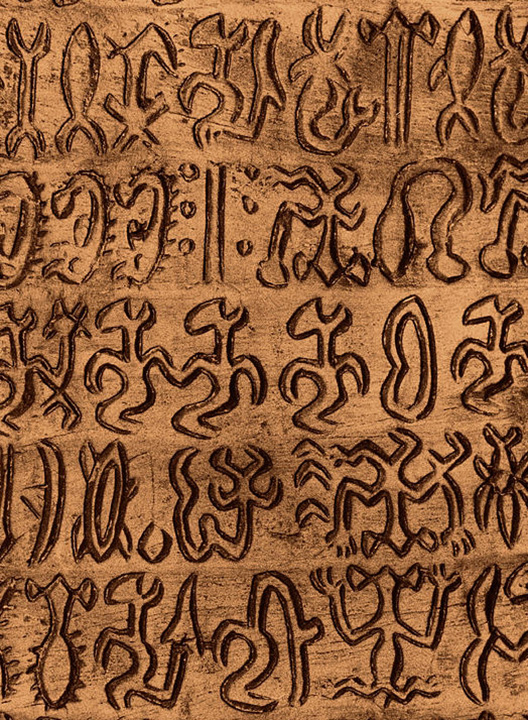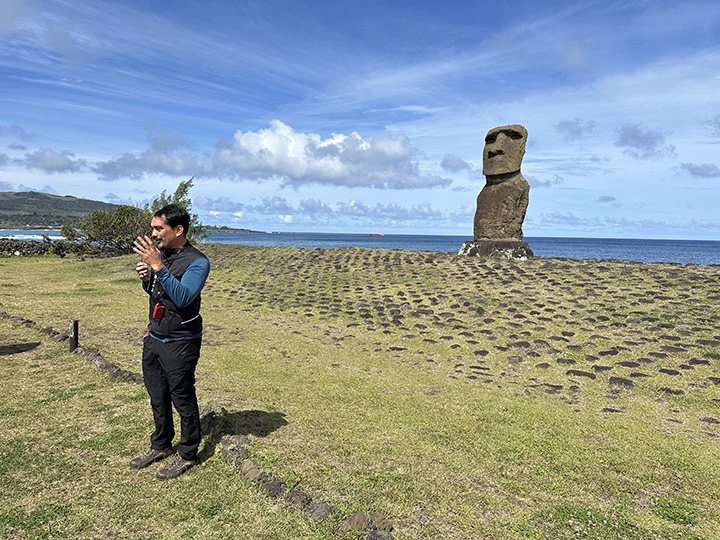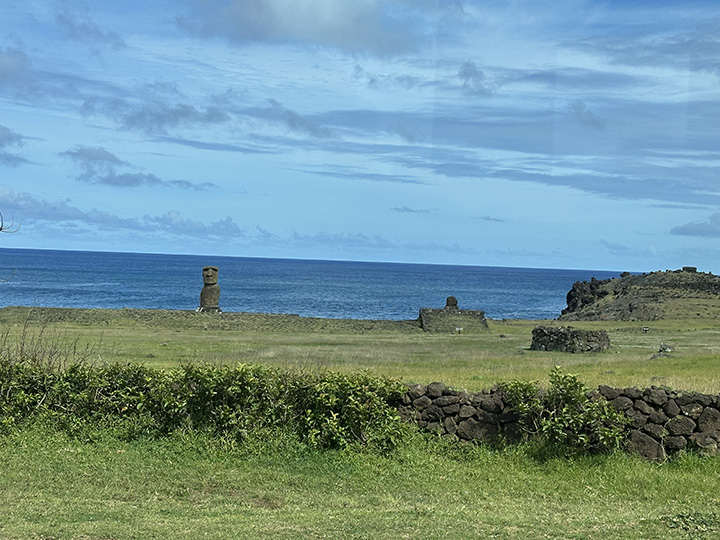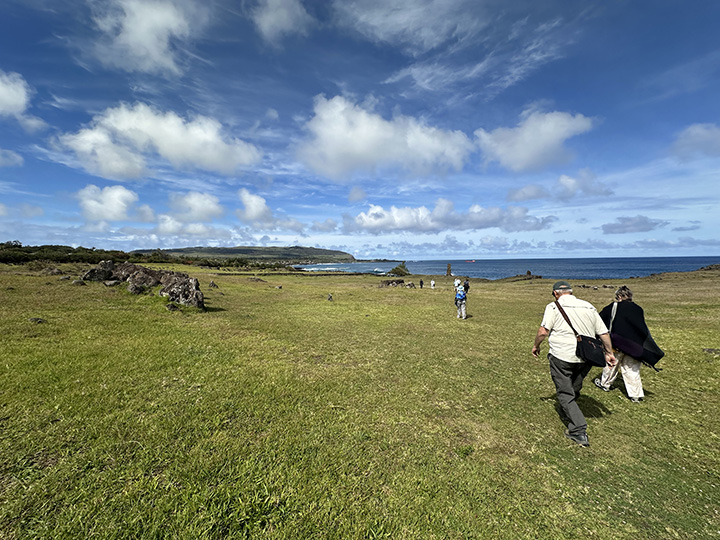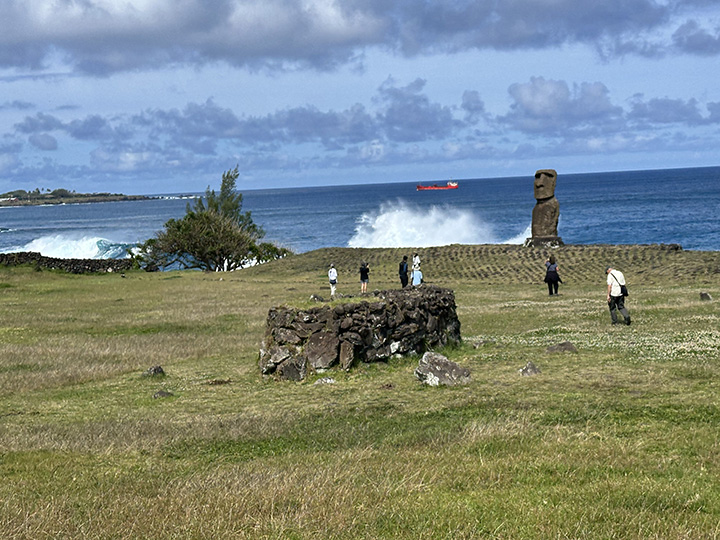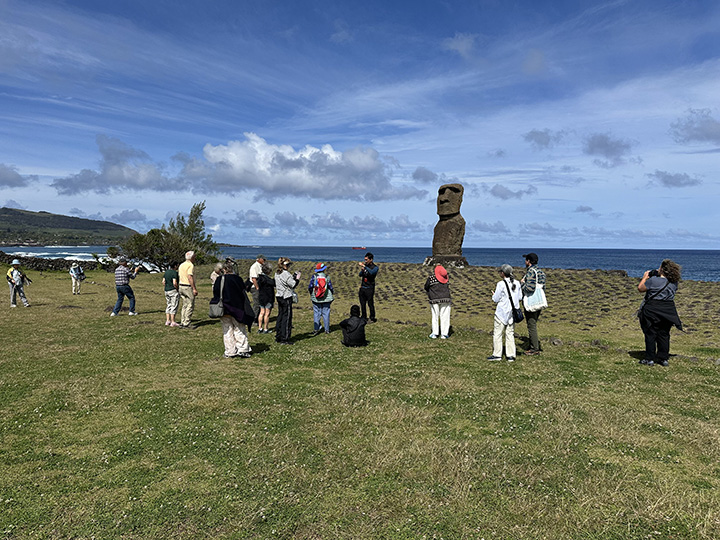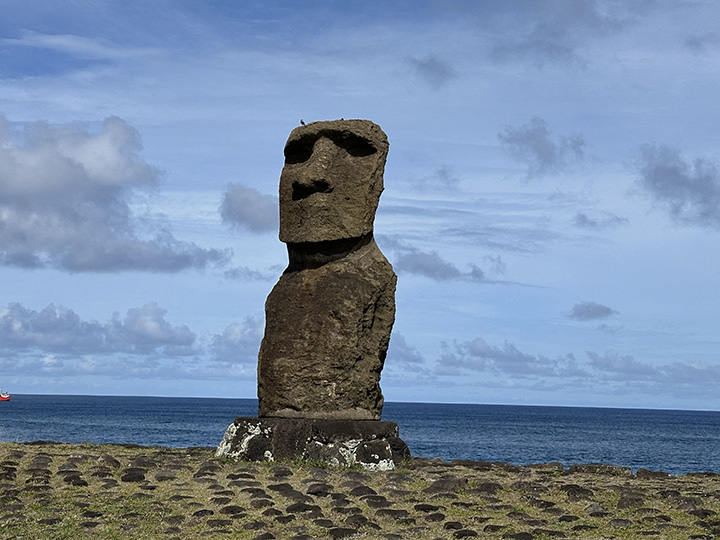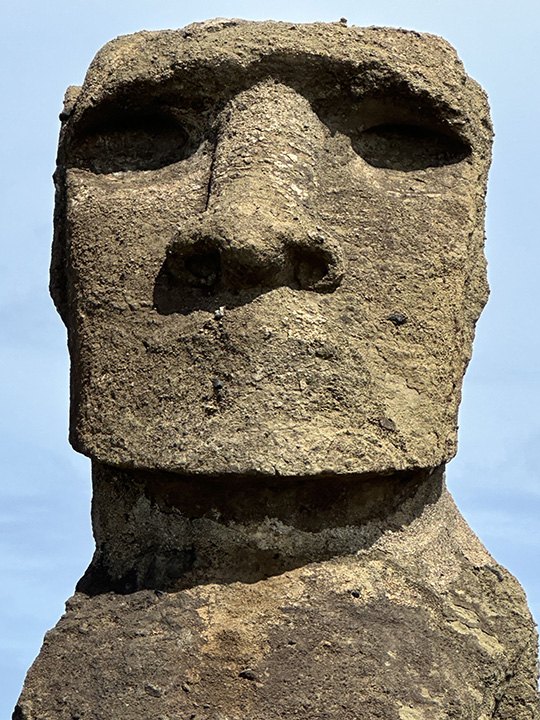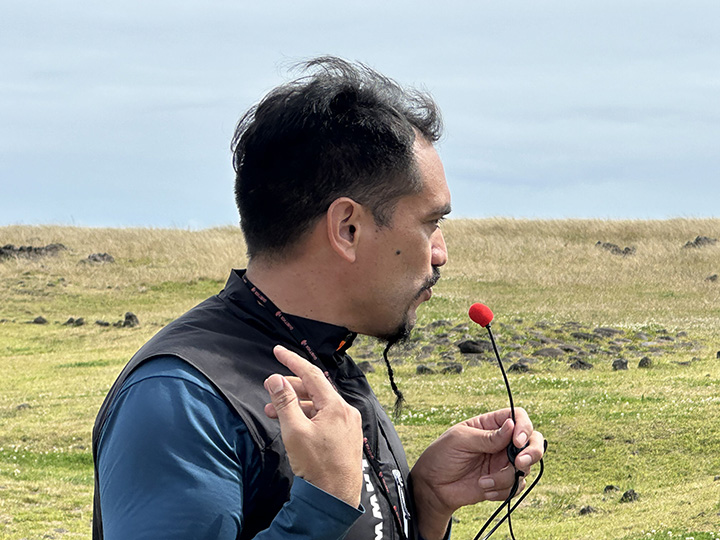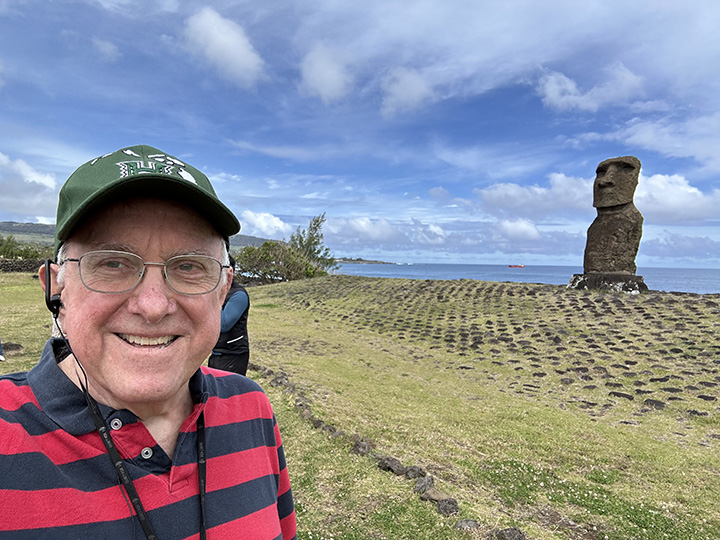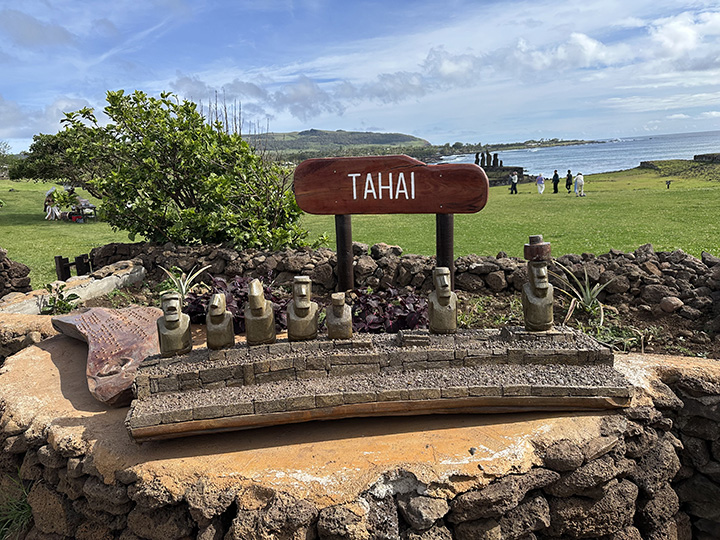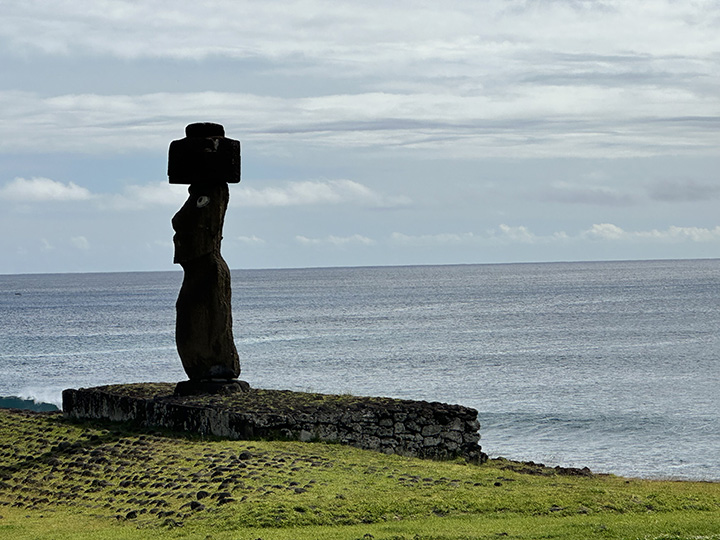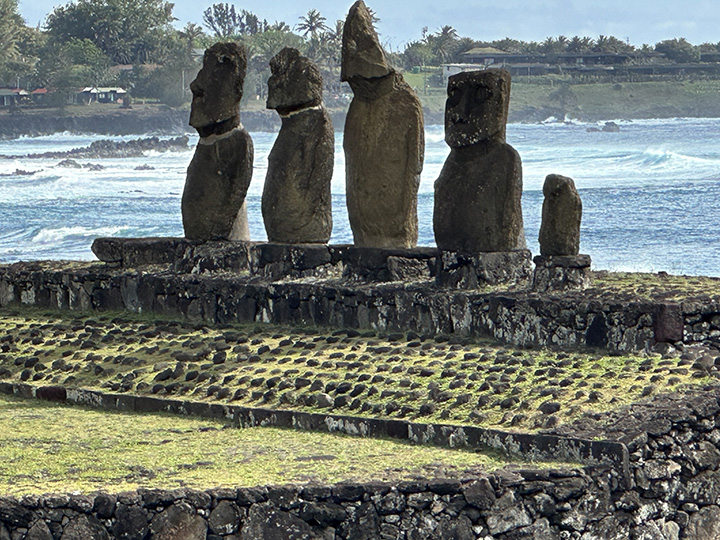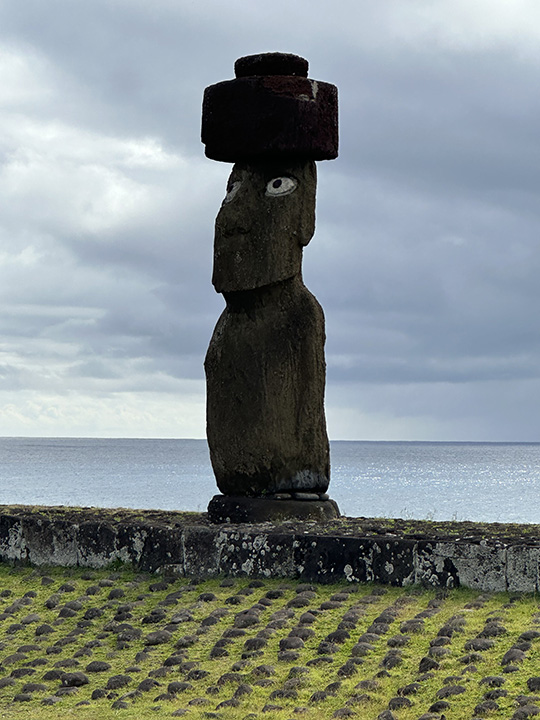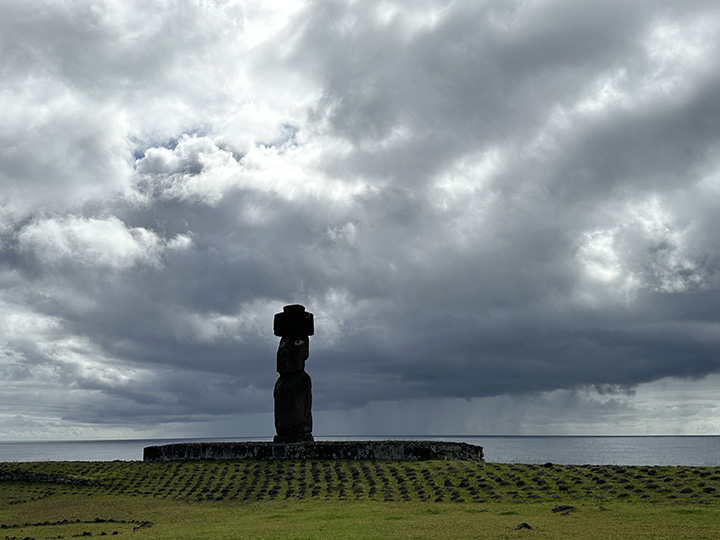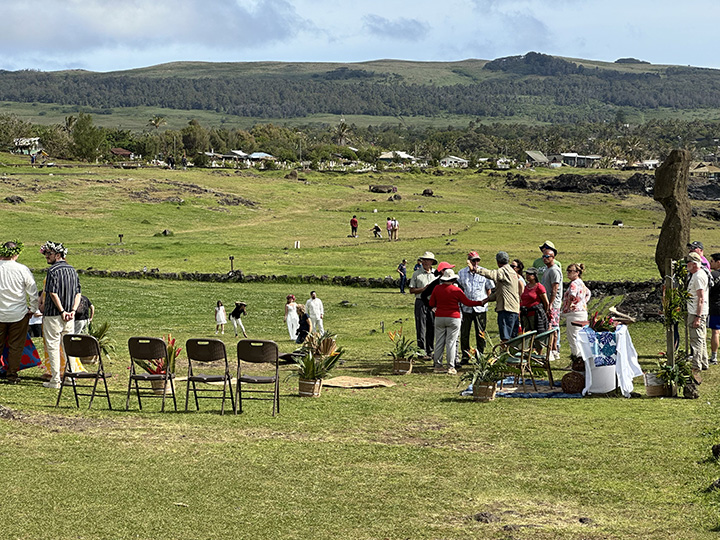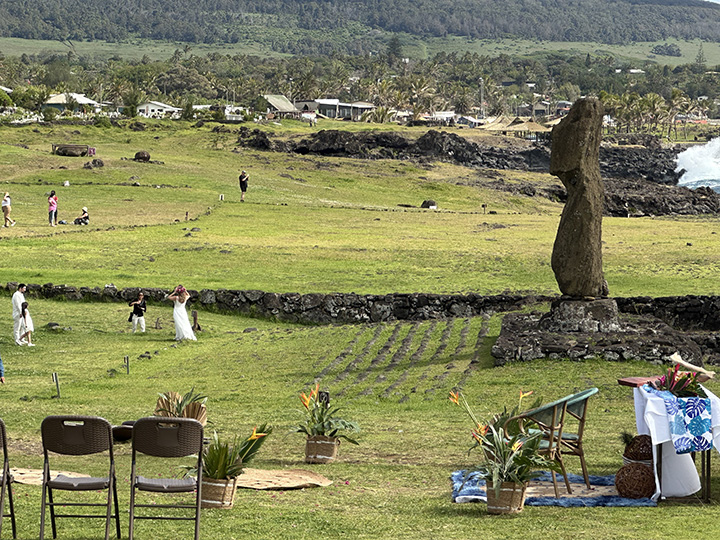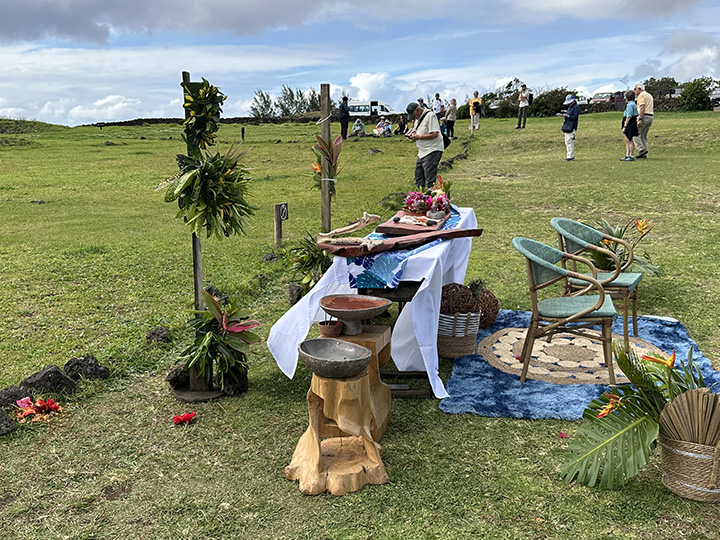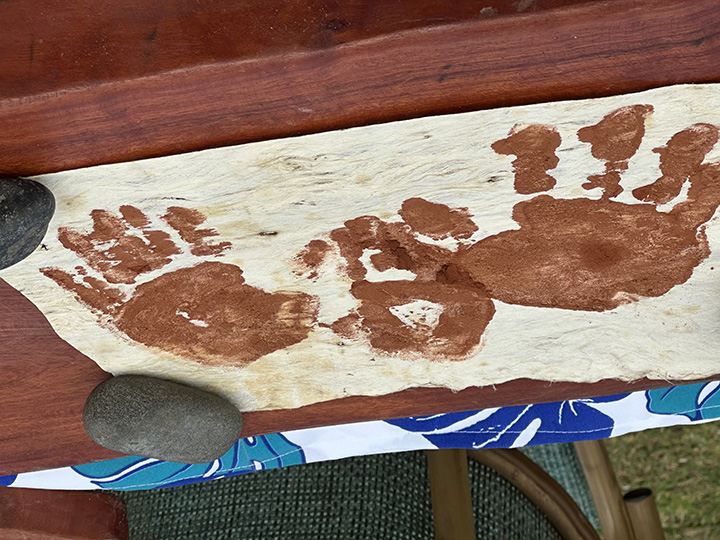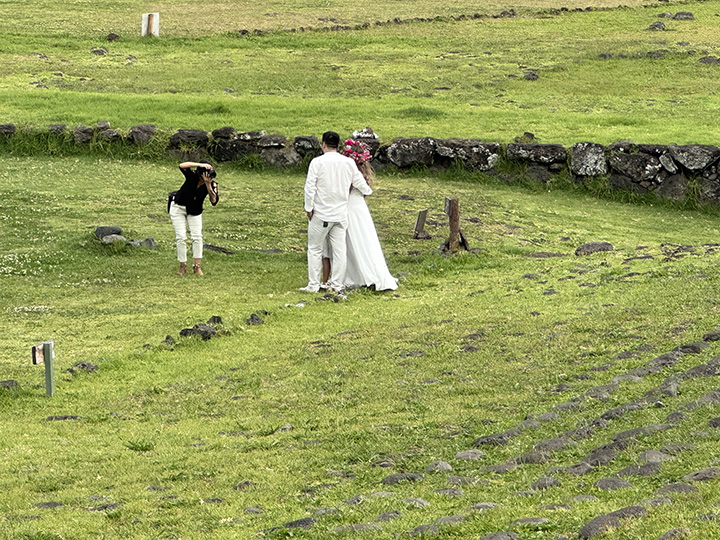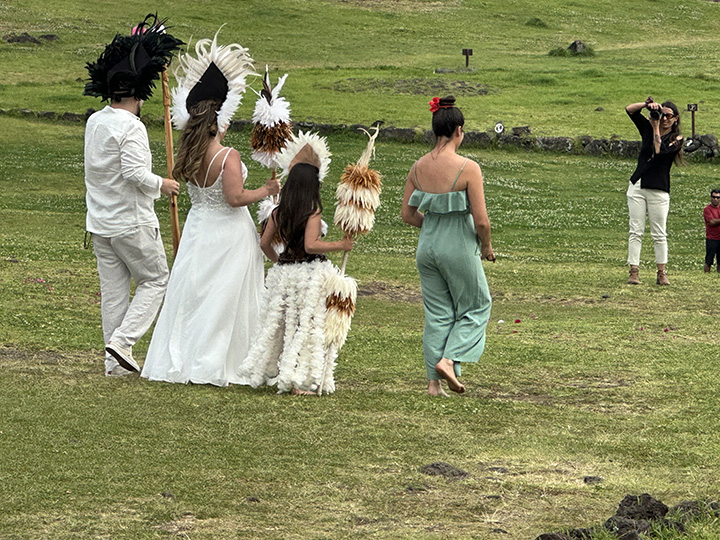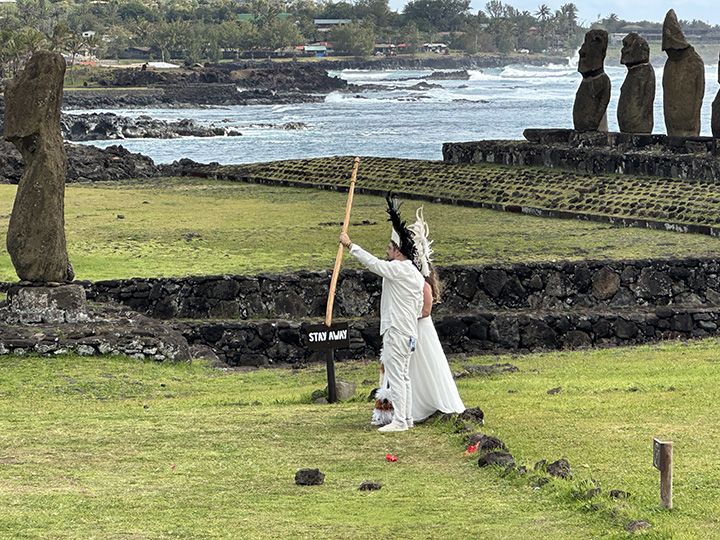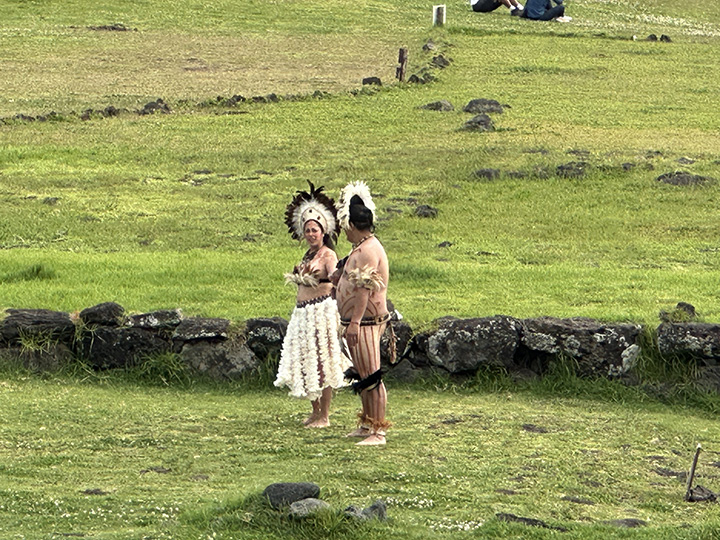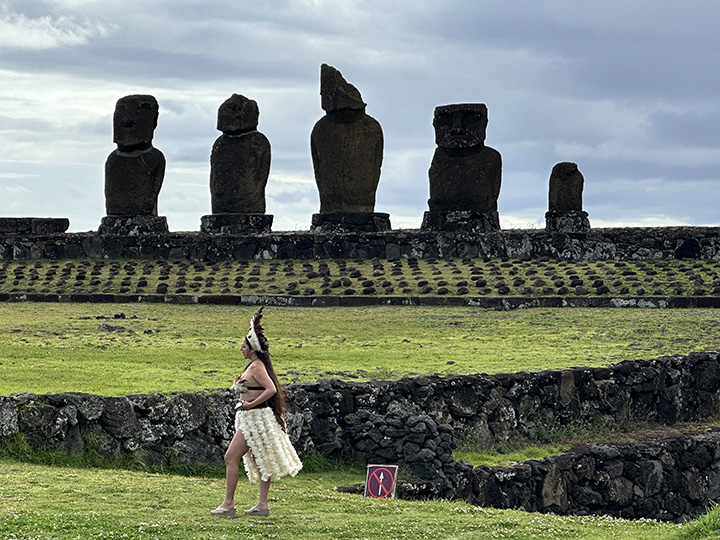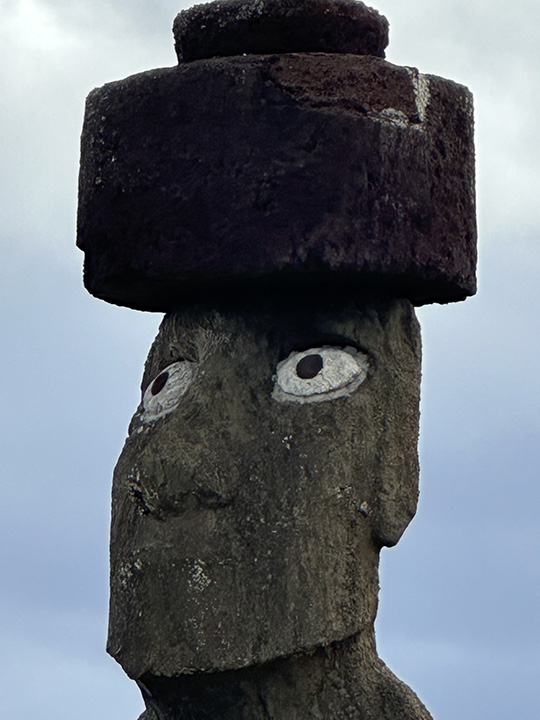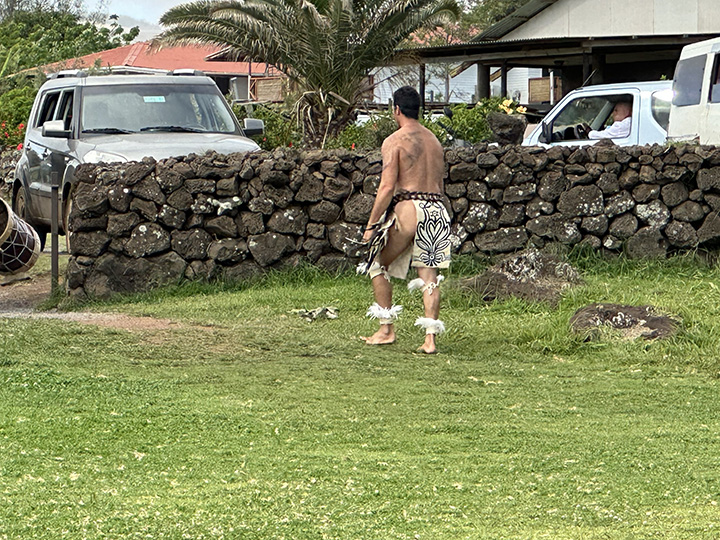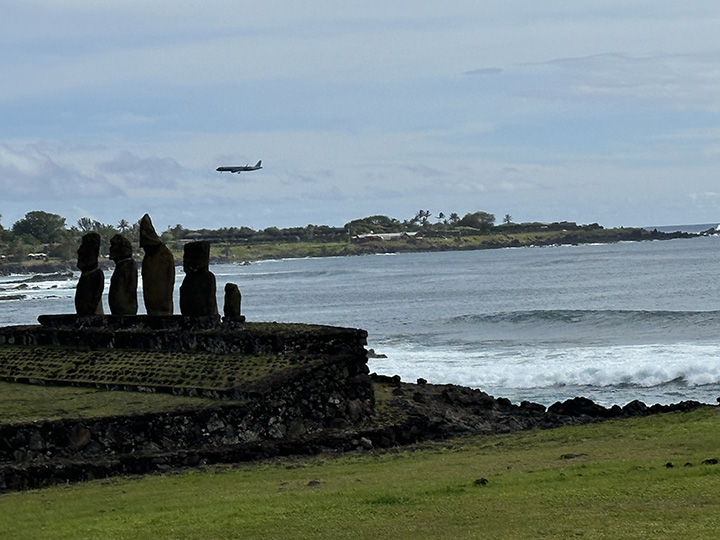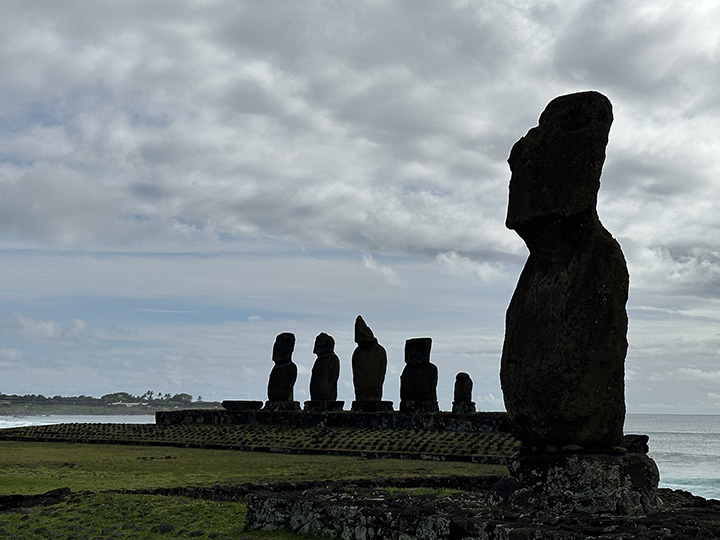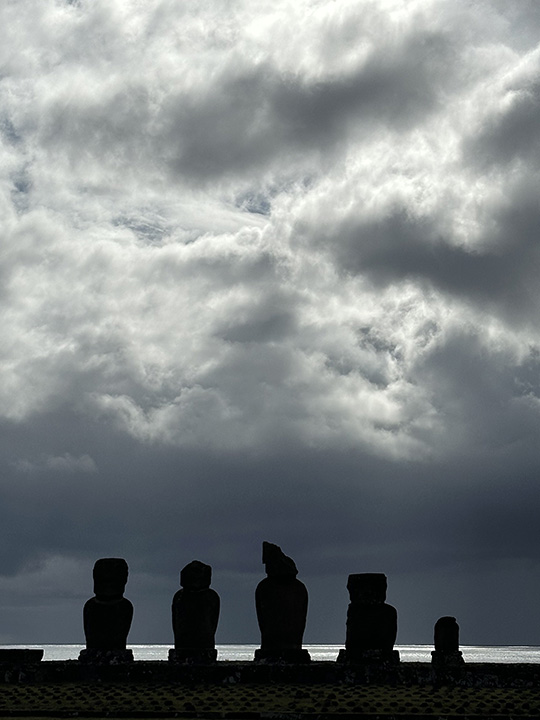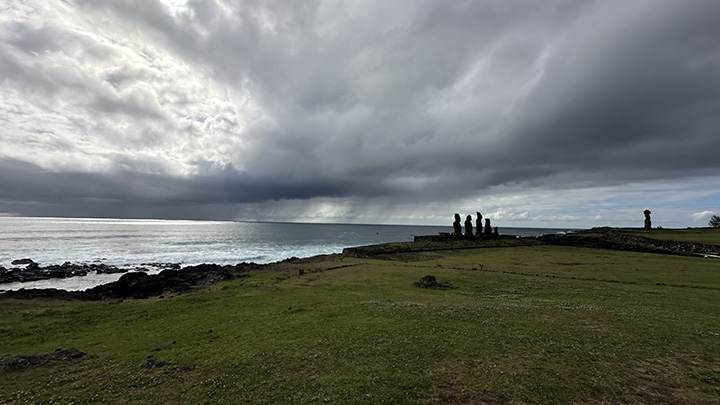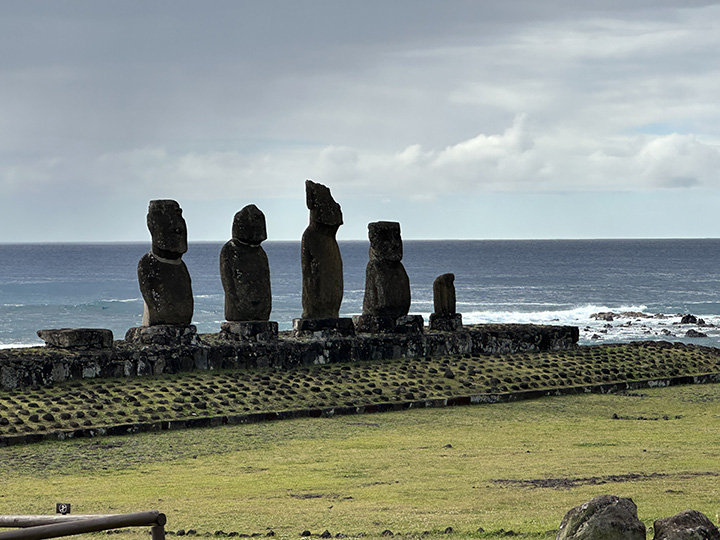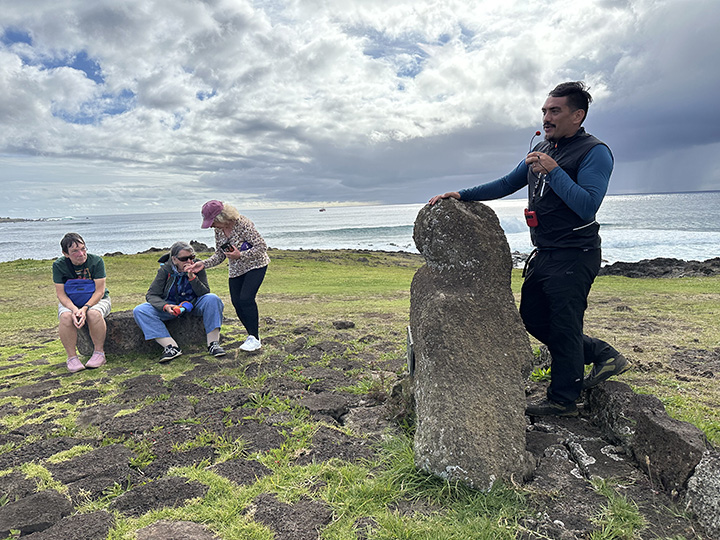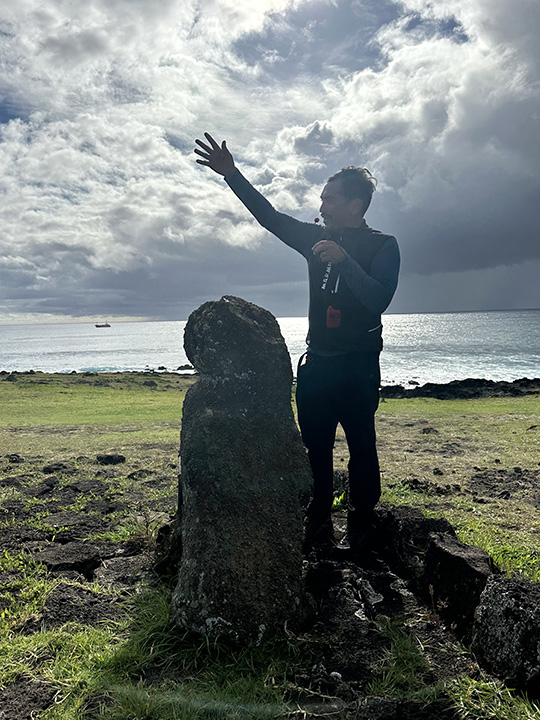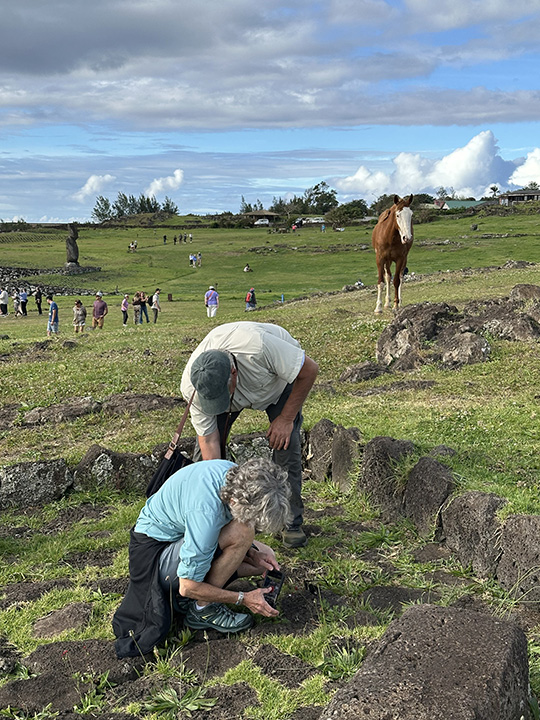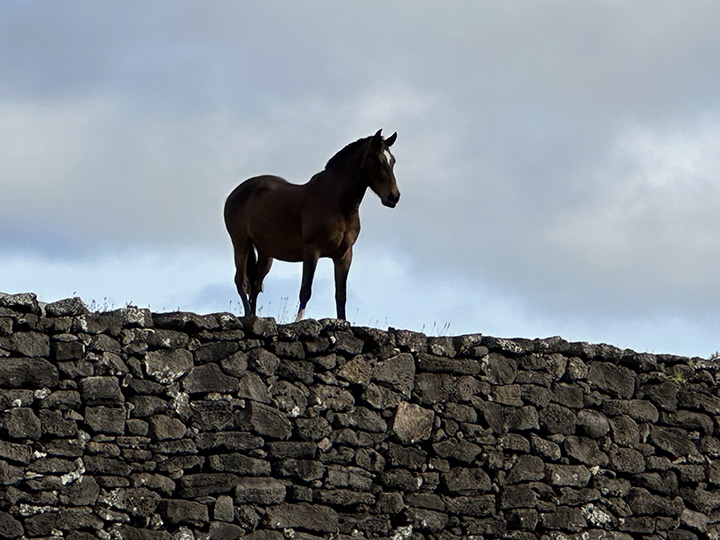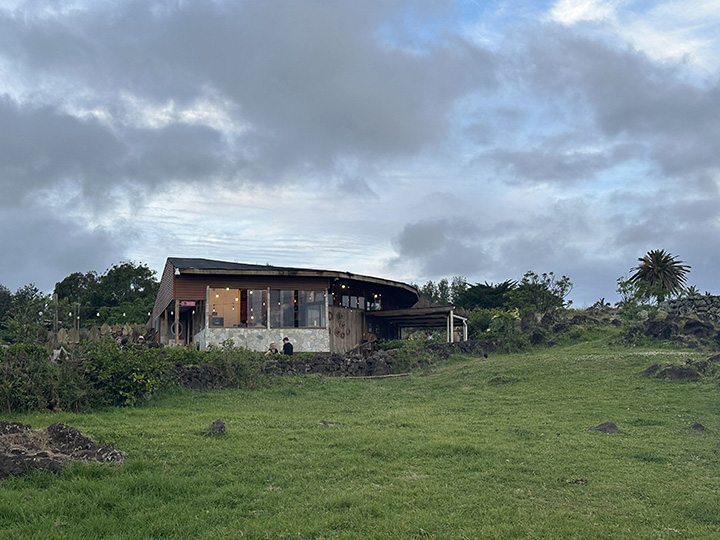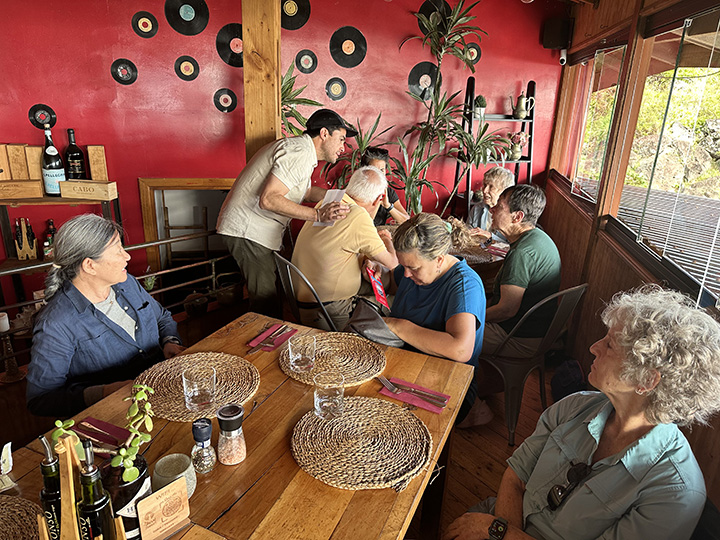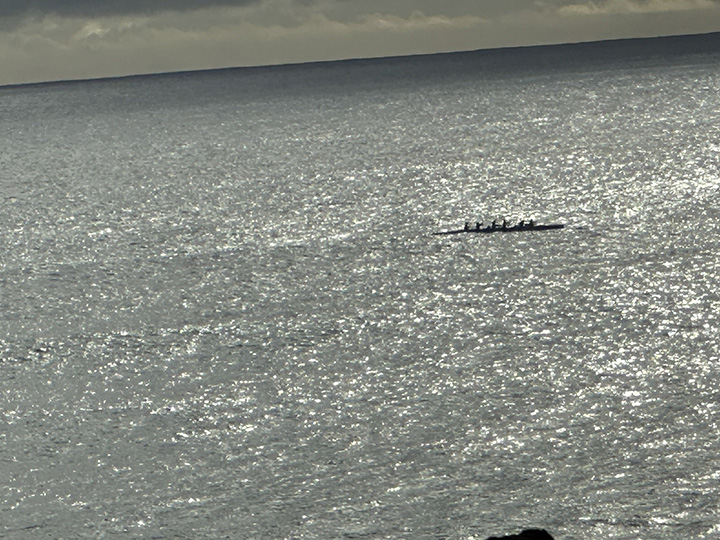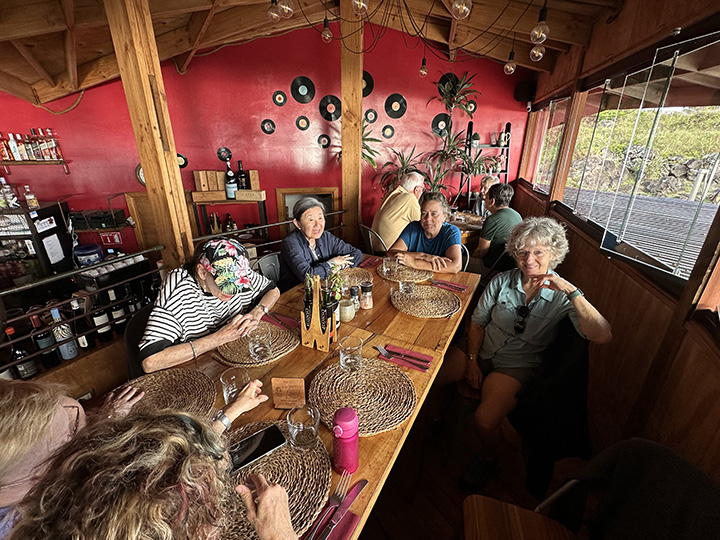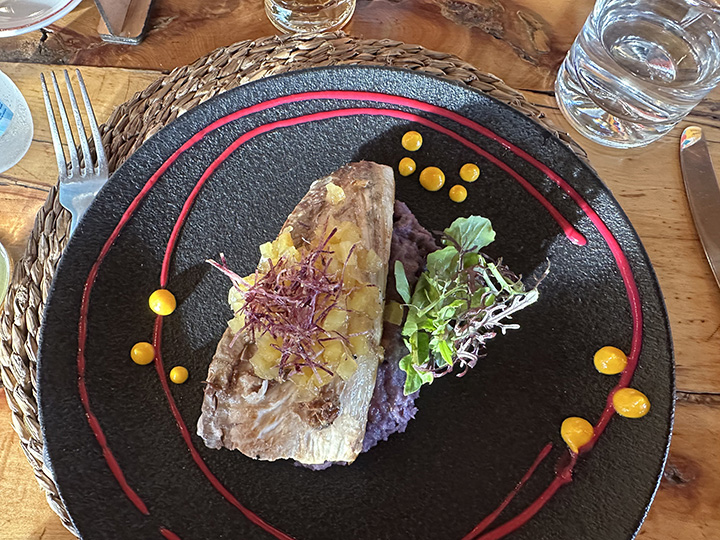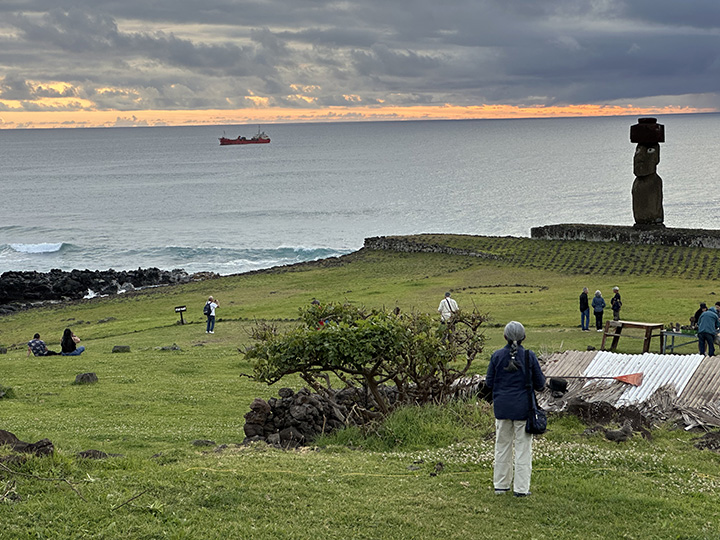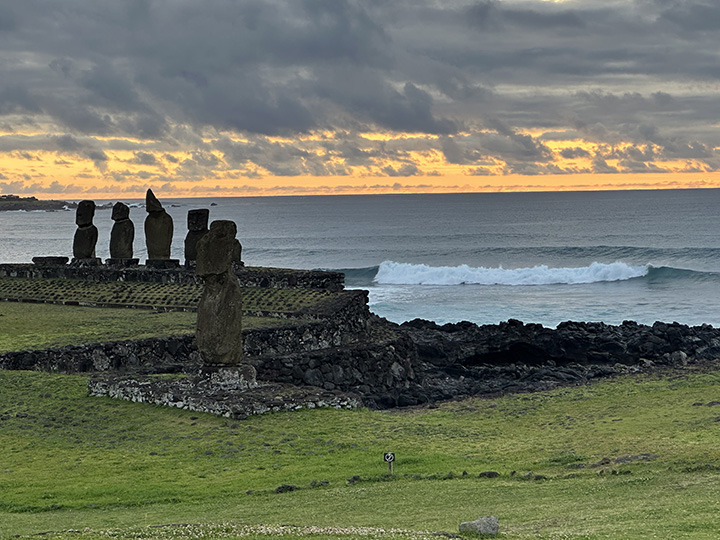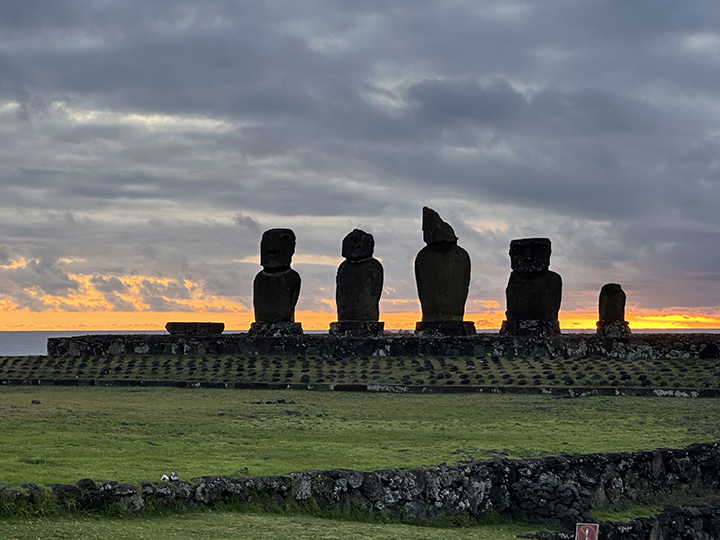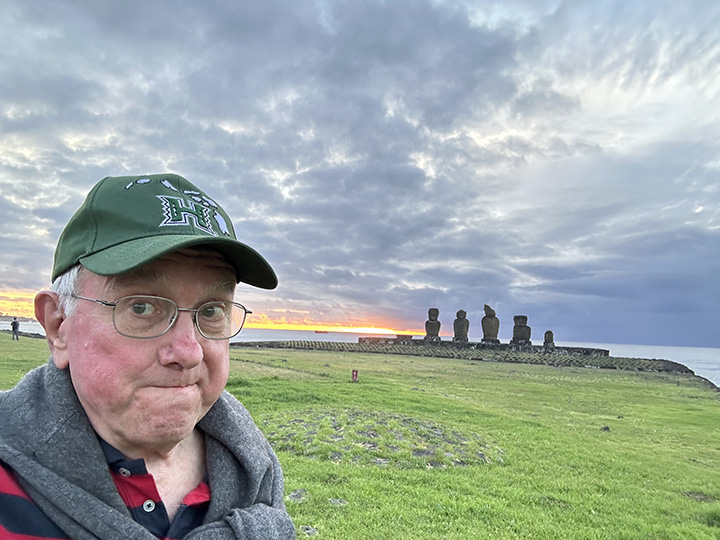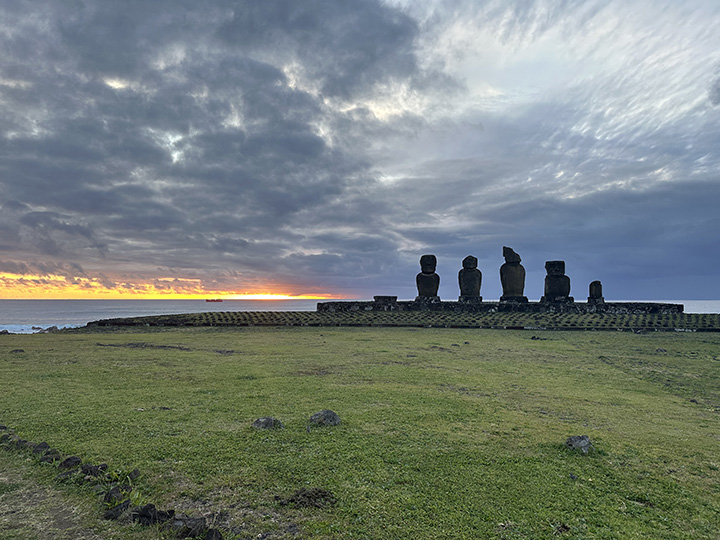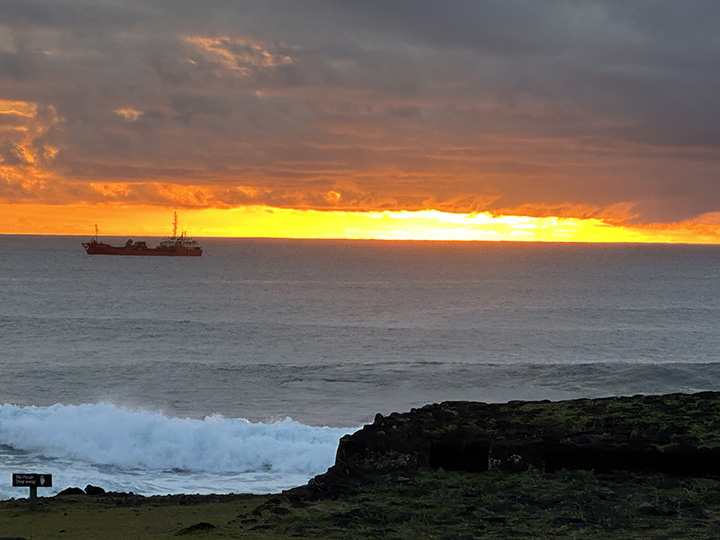|
Today was our first full day on Rapa Nui.
This guy woke me up much earlier than I would’ve liked. No alarm clock required on Rapa Nui, just one of the many amenities offered by Hotel Otai.
This is our local guide, Cristian. He is a delightful lecturer and he really knows his stuff. We listened to him for an hour and a half this morning and I did not want the session to end. He filled us in on the history of Easter Island And talked about what he hated to call the “mysteries.“ He is sure that with enough scholarly investigation someday we will come to a much better understanding of how Easter Island society came to exist and to develop over the years. He talked about the three ways we have learned about Easter Island society: oral tradition, archaeology, and reports from the Europeans who discovered the island in 1722 and continued to stop by to pick up provisions at first, and then pick up candidates for slavery afterward. The island does not have a happy history.
Since it’s not a good idea to drink the local tapwater, Road Scholar provides good stuff for us to fill our water bottles with. This will last me for the day.
We were supposed to visit a museum but it was closed because local protesters want the land the museum is on to be returned to the native population.
They have occupied the land, but not the museum itself because if they enter the building they are breaking the law and the police will get them. So right now it’s a standoff. This is probably my only real disappointment in the trip. I had hoped to visit the museum because I had heard it contained replicas of rongorongo tablets. What's that, you ask? Cristian talked about rongorongo yesterday but rather than try to recreate his comments from memory I have pulled some pictures and explanation from Wikipedia:
Rongorongo is a system of glyphs discovered in the 19th century on Easter Island that has the appearance of writing or proto-writing. Numerous attempts at decipherment have been made, but none have been successful. Although some calendrical and what might prove to be genealogical information has been identified, none of the glyphs can actually be read. If rongorongo does prove to be writing and to be an independent invention, it would be one of very few inventions of writing in human history. Two dozen wooden objects bearing rongorongo inscriptions, some heavily weathered, burned, or otherwise damaged, were collected in the late 19th century and are now scattered in museums and private collections. None remain on Easter Island. The objects are mostly tablets shaped from irregular pieces of wood, sometimes driftwood, but include a chieftain's staff, a tangata manu statuette, and two reimiro ornaments. There are also a few petroglyphs which may include short rongorongo inscriptions. Oral history suggests that only a small elite was ever literate and that the tablets were sacred. Authentic rongorongo texts are written in alternating directions, a system called reverse boustrophedon. In a third of the tablets, the lines of text are inscribed in shallow fluting carved into the wood.
So can you read that? Me neither. But it's all pretty interesting, don't you think?
So instead of visiting the museum, we listened to Cristian talk about the moai and their significance.
Sometimes getting to an ahu involves a bit of walking.
The Road Scholars are not deterred.
The views are worth it.
Do you have any idea how long you have to wait to snap a picture at just the right moment to catch a crashing wave?
We have earpieces called “whispers” that enable us to hear what Cristian is saying even while we wander about.
During the 19th century all the island's moai had fallen over for one reason or another. This guy has been returned to his pedestal (ahu) so the tourists will have something to look at.
Apparently the Rapanui people (the island is called Rapa Nui and the people are called Rapanui) began building these huge statues around the year 1200 A.D. soon after they arrived, and quit building them around the 1600s. Why? Nobody is sure.
What we do know is that when the first Europeans arrived on a Dutch sailing ship in 1722, many of the moai had fallen over and new ones were not being constructed.
He has been fixed up for tourists. See how his head had broken off and it has been reattached with cement? If he could talk I'll bet he'd have some fascinating stories to tell.
That's OK. Cristian is filling in nicely. This was where I first noticed Cristian’s chin whiskers. He is speaking into the microphone that takes his voice to the whispers in our ears.
See my whisper?
Oh boy! Lunch back at the hotel.
And then back to sightseeing at Ahu Tahai where there are many more moai.
That's not a hat. It's a hairdo.
They are looking in from the ocean not out at sea. That’s because they bring strength (mana) to the small village that sat before them.
All of them once had eyes like that, made of coral with an iris made of black stone from a quarry. But they didn’t wear their eyes all the time. When western ships would appear, the people would remove the eyes and hide them so that the strength would not be imparted to the visitors. It was only in the 20th century that archaeologists realized those strange coral shapes they had found were not digging instruments but instead were moai eyes.
Can you feel the mana?
Oh look, we've arrived to find there has been a wedding in progress.
Cristian says these people are from Chile as no self-respecting Rapanui would put on such a spectacle.
That's where the happy couple took their vows.
And that's where they played in the fingerpaints.
The wedding photographer goes about her business.
Say cheese!
The groom's staff probably represents something or other.
I think that's the maid of honor and the best man.
The maid of honor cuts a striking figure in front of the no staffs sign.
Wait, what's that I am seeing?
Mooned by an usher.
It's the daily flight from Santiago. The moai are unimpressed.
They've seen it all before.
It's all part of the job.
Sending the mana.
Keeping watch.
Another day, another flock of tourists.
This tourist is feeling full of mana.
Cristian has some interesting info to impart.
He's telling us about "Uncle" Thor Heyerdahl's assertion that Rapa Nui was populated by people from South America -- a theory he was never able to prove and that he was almost certainly wrong about. Wikipedia says: Thor Heyerdahl (October 1914 – 18 April 2002) was a Norwegian adventurer and ethnographer with a background in biology with specialization in zoology, botany and geography. Heyerdahl is notable for his Kon-Tiki expedition in 1947, in which he drifted 8,000 km (5,000 mi) across the Pacific Ocean in a primitive hand-built raft from South America to the Tuamotu Islands. The basis of the Kon-Tiki expedition was Heyerdahl's belief that the original inhabitants of Easter Island (and the rest of Polynesia) were the "Tiki people", a race of "white bearded men" who supposedly originally sailed from Peru. He described these "Tiki people" as being a sun-worshipping fair-skinned people with blue eyes, fair or red hair, tall statures, and beards. He further said that these people were originally from the Middle East, and had crossed the Atlantic earlier to found the great Mesoamerican civilizations. Heyerdahl said that when the Europeans first came to the Pacific islands, they were astonished that they found some of the natives to have relatively light skins and beards. There were whole families that had pale skin, hair varying in colour from reddish to blonde. In contrast, most of the Polynesians had golden-brown skin, raven-black hair, and rather flat noses. Heyerdahl claimed that when [the Dutch] discovered Easter Island in 1722, [they] supposedly noticed that many of the natives were white-skinned. Heyerdahl claimed that these people could count their ancestors who were "white-skinned" right back to the time of Tiki and Hotu Matua, when they first came sailing across the sea "from a mountainous land in the east which was scorched by the sun." The ethnographic evidence for these claims is outlined in Heyerdahl's book Aku-Aku: The Secret of Easter Island. He argued that the monumental statues known as moai resembled sculptures more typical of pre-Columbian Peru than any Polynesian designs. He believed that the Easter Island myth of a power struggle between two peoples called the Hanau epe and Hanau momoko was a memory of conflicts between the original inhabitants of the island and a later wave of "Native Americans" from the Northwest coast, eventually leading to the annihilation of the Hanau epe and the destruction of the island's culture and once-prosperous economy. Heyerdahl described these later "Native American" migrants as "Maori-Polynesians" who were supposedly Asians who crossed over the Bering land bridge into Northwest America before sailing westward towards Polynesia (the westward direction is because he refused to accept that Polynesians were capable of sailing against winds and currents). He associated them with the Tlingit and Haida peoples and characterized them as "inferior" to the Tiki people. Despite these claims, DNA sequence analysis of Easter Island's current inhabitants indicates that the 36 people living on Rapa Nui who survived the devastating internecine wars, slave raids, and epidemics of the 19th century and had any offspring were Polynesian. Furthermore, examination of skeletons offers evidence of only Polynesian origins for Rapa Nui living on the island after 1680. Heyerdahl's hypothesis of Polynesian origins from the Americas is considered pseudoscientific, racially controversial, and has not gained acceptance among scientists. It is overwhelmingly rejected by scientists today. Archaeological, linguistic, cultural, and genetic evidence all support a western origin (from Island Southeast Asia) for Polynesians via the Austronesian expansion. "Drift voyaging" from South America was also deemed "extremely unlikely" in 1973 by computer modeling. Sounds like Uncle Thor may have been something of a crackpot.
That moai remnant Cristian is standing beside is actually a memorial to William Mulloy, a professor of anthropology at the University of Wyoming who was brought to Rapa Nui by Thor Heyerdahl. Wikipedia says: William Thomas Mulloy Jr. (May 3, 1917 – March 25, 1978) was an American anthropologist. While his early research established him as a formidable scholar and skillful fieldwork supervisor in the province of North American Plains archaeology, he is best known for his studies of Polynesian prehistory, especially his investigations into the production, transportation and erection of the monumental statuary on Rapa Nui (Easter Island) known as moai. Mulloy's Rapa Nui projects include the investigation of the Akivi-Vaiteka Complex and the physical restoration of Ahu Akivi (1960); the investigation and restoration of Ahu Ko Te Riku and Ahu Vai Uri and the Tahai Ceremonial Complex (1970); the investigation and restoration of two ahu at Hanga Kio'e (1972); the investigation and restoration of the ceremonial village at Orongo (1974) and numerous other archaeological surveys throughout the island. In particular, Mulloy's restoration projects on the island earned him the great respect of Rapa Nui islanders, many of whom collaborated with him at multiple venues. In 1978, in recognition of his distinguished and unselfish work on behalf of the Rapa Nui community, Mulloy was named Illustrious Citizen of Easter Island.
The Mulloy monument at Tahai bears inscriptions in three languages: Rapa Nui, English and Spanish. In Rapa Nui, the epitaph reads: Hai hāpī, hai haka tutu‘u i te ‘ariŋa ora, to‘ona here rahi mo Rapa Nui i haka tikea mai ai (By studying and raising up the living faces (moai), he showed us his great love for Rapa Nui). The commemoration in English states: "By restoring the past of his beloved island he also changed its future." Finally, the Spanish tribute says: Grande fue - como sus obras - su amor y entrega a Rapa Nui (As his works were great, so too was his love and sacrifice for Rapa Nui).
Tove and John (or is that Tom?) have found some interesting rocks. Even the horse is interested.
The horses just go where the horses want to go. If only the dogs would leave them alone.
Yes, that tumble really was embarassing.
This guy is king of the hill.
There's food up there.
Dinnertime at the Te Moai Sunset Restaurant.
The place had a nice view of the western horizon complete with outrigger.
But before there's a sunset, we need to eat.
Yummy fish. Road Scholar really knows how to pick the places.
Now let's go out and watch the sun go down.
I wonder if the moai resent being turned away from the pretty sunsets?
I'd be ticked off.
He's glad he's not a moai.
Getting kinda spectacular.
Wow.
Sunset in motion.
And that's it for this evening. We went back to the hotel and prepared ourselves for more moai tomorrow.
|

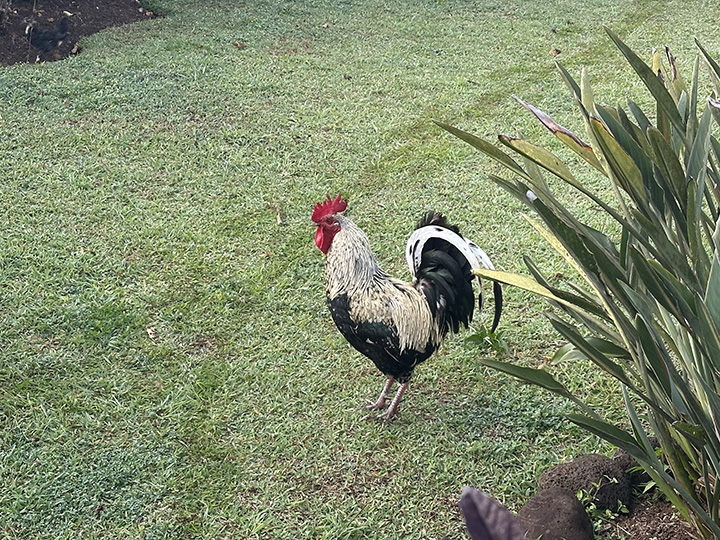

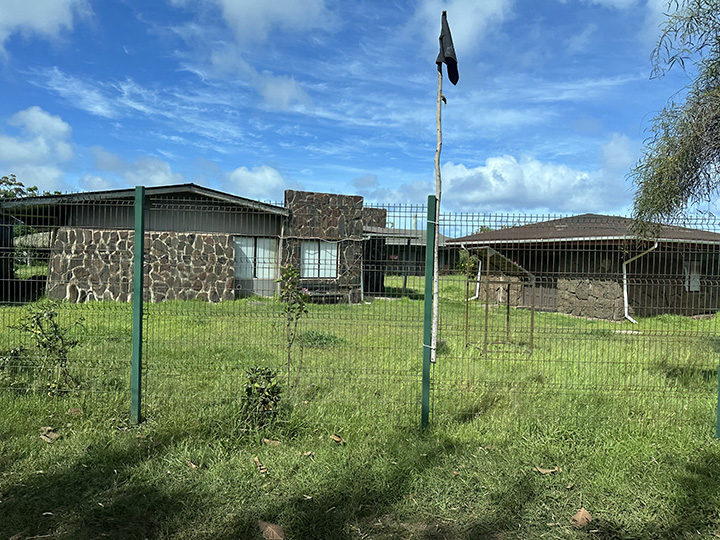
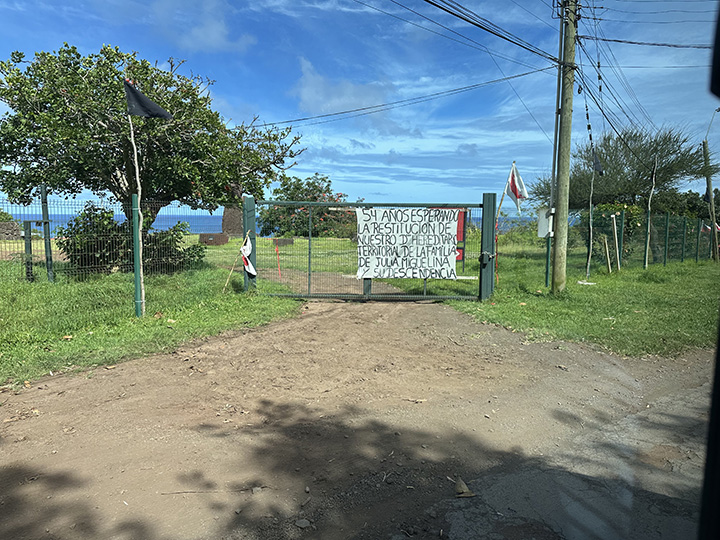
_edit1.jpg)
